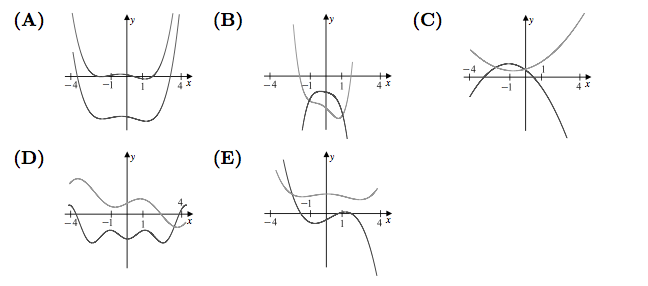Difference between revisions of "2002 AMC 12A Problems/Problem 25"
(→Solution 2) |
(→Solution 2a) |
||
| Line 16: | Line 16: | ||
Proceed similarly to Solution 2. However, note that <math>x^n + ... + x + 1</math> is a factor of <math>x^{n+1}-1.</math> The only potential zeroes of <math>x^{n+1}-1</math> are <math>1</math> and <math>-1</math> if <math>n+1</math> is even. Since none of the graphs have a zero at exactly negative one, the solution is the graph with no zeroes, which is <math>\boxed{(B)}.</math> | Proceed similarly to Solution 2. However, note that <math>x^n + ... + x + 1</math> is a factor of <math>x^{n+1}-1.</math> The only potential zeroes of <math>x^{n+1}-1</math> are <math>1</math> and <math>-1</math> if <math>n+1</math> is even. Since none of the graphs have a zero at exactly negative one, the solution is the graph with no zeroes, which is <math>\boxed{(B)}.</math> | ||
| + | |||
| + | ~~AndrewZhong2012~~ | ||
==See Also== | ==See Also== | ||
Latest revision as of 08:40, 31 July 2025
Problem
The nonzero coefficients of a polynomial ![]() with real coefficients are all replaced by their mean to form a polynomial
with real coefficients are all replaced by their mean to form a polynomial ![]() . Which of the following could be a graph of
. Which of the following could be a graph of ![]() and
and ![]() over the interval
over the interval ![]() ?
?
Solution 1
The sum of the coefficients of ![]() and of
and of ![]() will be equal, so
will be equal, so ![]() . The only answer choice with an intersection between the two graphs at
. The only answer choice with an intersection between the two graphs at ![]() is (B). (The polynomials in the graph are
is (B). (The polynomials in the graph are ![]() and
and ![]() .)
.)
Solution 2
We know every coefficient is equal, so we get ![]() which equals
which equals ![]() . We see apparently that x cannot be positive, for it would yield a number greater than zero for
. We see apparently that x cannot be positive, for it would yield a number greater than zero for ![]() . We look at the zeros of the answer choices. A, C, D, and E have a positive zero, which eliminates them. B is the answer.
. We look at the zeros of the answer choices. A, C, D, and E have a positive zero, which eliminates them. B is the answer.
Solution 2a
Proceed similarly to Solution 2. However, note that ![]() is a factor of
is a factor of ![]() The only potential zeroes of
The only potential zeroes of ![]() are
are ![]() and
and ![]() if
if ![]() is even. Since none of the graphs have a zero at exactly negative one, the solution is the graph with no zeroes, which is
is even. Since none of the graphs have a zero at exactly negative one, the solution is the graph with no zeroes, which is ![]()
~~AndrewZhong2012~~
See Also
| 2002 AMC 12A (Problems • Answer Key • Resources) | |
| Preceded by Problem 24 |
Followed by Last Problem |
| 1 • 2 • 3 • 4 • 5 • 6 • 7 • 8 • 9 • 10 • 11 • 12 • 13 • 14 • 15 • 16 • 17 • 18 • 19 • 20 • 21 • 22 • 23 • 24 • 25 | |
| All AMC 12 Problems and Solutions | |
These problems are copyrighted © by the Mathematical Association of America, as part of the American Mathematics Competitions. ![]()










